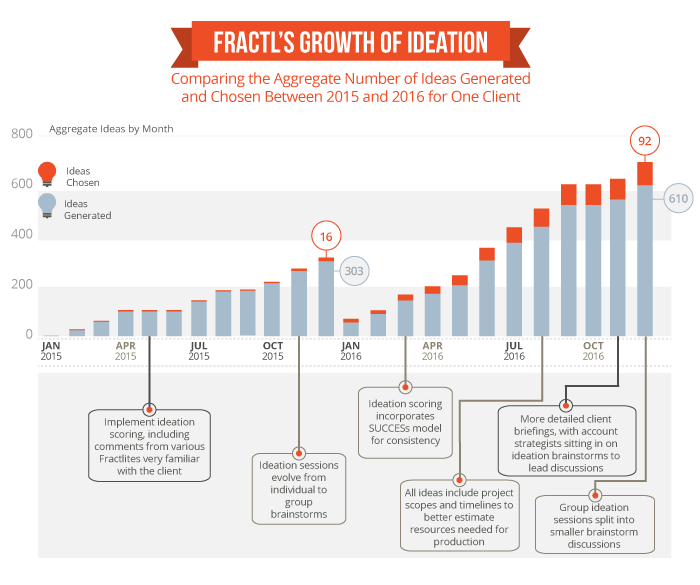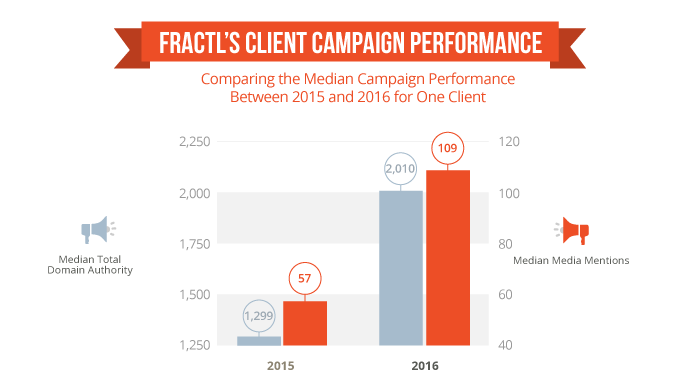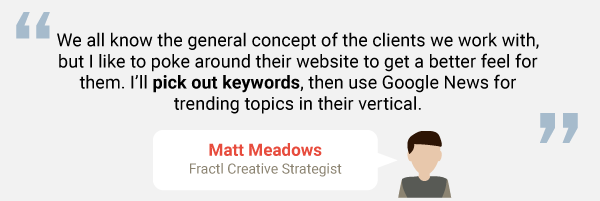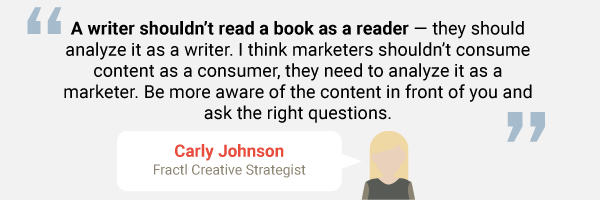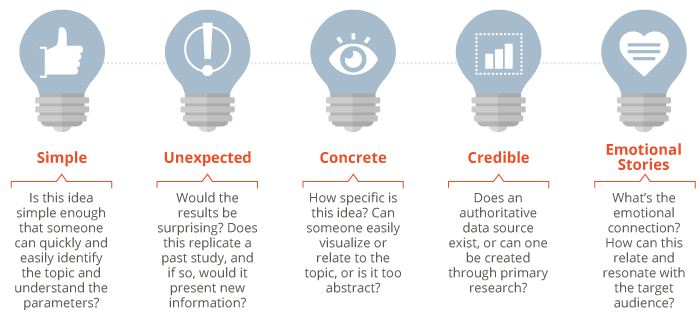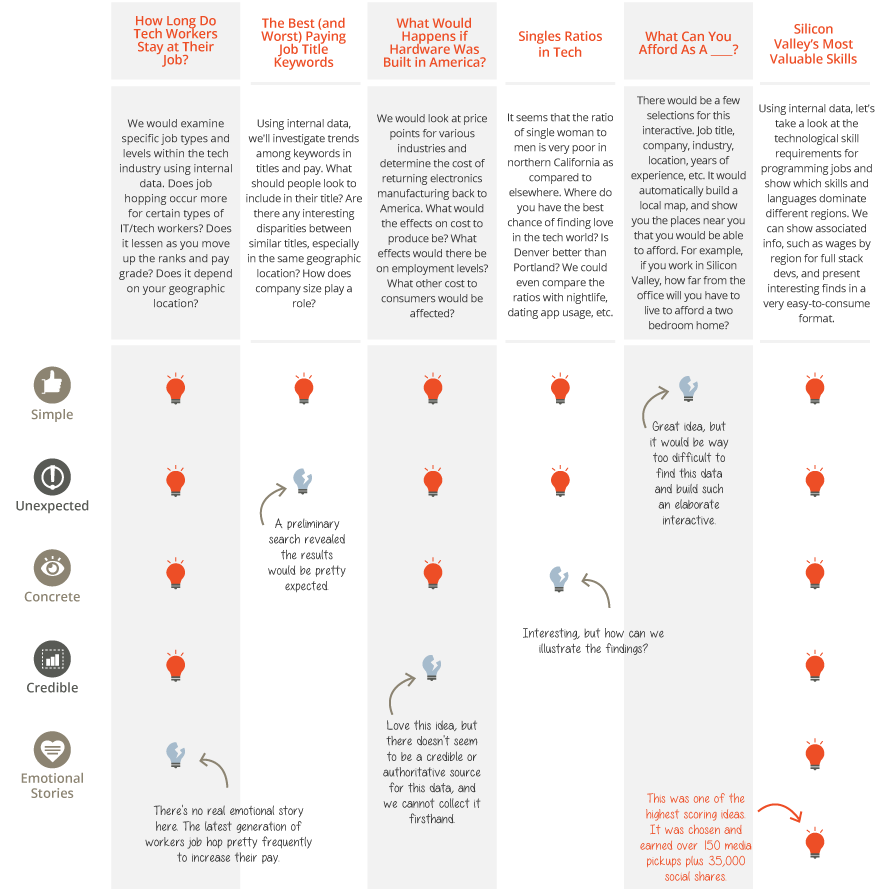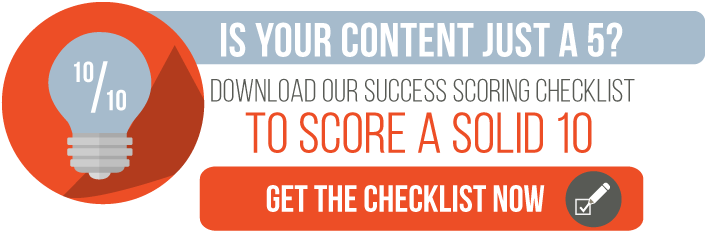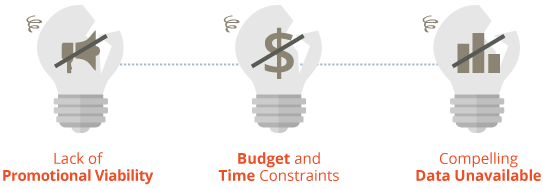Anyone can spot a good idea, but what makes a great idea? That’s something we ask ourselves every single day, and we’ve done countless experiments, analyses, and studies to answer that question. Each lesson we learn helps us further innovate and perfect our content ideation process, which up until now, has been a pretty mysterious part of our agency (or so we’ve been told).
But what is ideation? As much as we love data-driven content, we consider ideation an art rather than a science given that there’s no consistent, go-to formula for coming up with a great idea. You can put a dozen mathematicians in a room with one equation to solve and will get the same answer, but if you put a dozen artists in a room with a still life to draw, you’ll get 12 very different drawings.
We consider ideation to be more of scenario two; each one of our creative strategists can offer unique insights, expert opinions, and past experience to create a completely original idea to solve a client’s problem.
To help give a better idea of how we come up with our content ideas, we decided to offer an insider’s perspective of Fractl’s ideation process. From looking back at our past processes to explaining how we currently run the show, the following will offer some ideation insights to demystify what it takes for us to come up with a great idea that’s behind every great piece of content.
The Growth of Ideation
The past two years in particular have seen some major changes to our process, so we pulled the data from 24 months for one client to find interesting insights. In total, we analyzed the data from nearly 20 ideation brainstorm sessions and found the total number of ideas we came up with doubled within just one year, while the number of ideas chosen to go on to production was almost six times higher than the previous year.
The timeline above illustrates how ideation has improved while also highlighting some major changes to our content ideation process. Some of these changes like scoring ideas were strategic decisions, but some came organically and proved to be more efficient and effective than previous processes.
Of course, we know quality is even more important than quantity, so we also measured the media performance of each idea chosen to ensure the KPIs were scaling just as quickly as the number of ideas going into production. We dug through dozens of reports to pull the performance metrics from completed campaigns for this same client; we found the median number of media placements and links nearly doubled while the median total domain authority increased by 55%.
Ideation Logistics & Current Ideation Process
While we know a creative environment fosters the best ideas, we still recognize there needs to be some structure in place to guide the ideation process. As seen in the timeline further above, it’s clear there have been numerous changes to perfect the process over the past two years. There’s always room for improvement, but for the most part, content ideation has always consisted of the following four steps:
Account Strategists Hold Client Briefings
Before ideation brainstorms begin, account strategists brief the creative team and anyone else involved in ideation. Familiarizing the team with the client’s mission and purpose means everyone is fully aware of the client’s specific audiences, production timelines and budgets, and marketing goals.
Information like keyword research or competitor analyses will be passed over to them to review before the brainstorm, and the creative team is encouraged to review past ideations and content for the client to understand what’s already performed well.
Creative Strategists Lead Group Brainstorms
We love our daily group brainstorm sessions, and believe collaboration is the secret to some of our best content ideas. While we’re all for free-flowing conversation and the tangents they bring, we’ve added some structure to each session to make sure we’re optimizing our time.
Every idea is recorded in a new spreadsheet and includes a few key factors. A content title and brief summary (ideally sprinkled with carefully considered keywords) is supplemented by other information like an identified data source or methodology, content format, and any accompanying graphic components (e.g., maps and interactives). These little details help give our senior team some context when scoring an idea (more on that below).
Come Prepared
Going into a brainstorm session with a handful of ideas or topics already at the front of your mind helps to get the creative juices flowing for the whole team. We pull from our go-to ideation inspiration sources (we’ll go into that in a bit) and are sure to be fully aware of the end goal – like increasing brand awareness, building links, or improving search rankings.
Keep an Open Mind
At this point, all ideas can become great content. Some of our best campaigns came from ideas developed through a brainstorming conversation where strategists went back and forth adding to an idea with a “yes, and” mindset rather than a “no, but” view.
Record Everything
We write down every single idea, no matter how ridiculous or far-flung it may seem at first. Maybe it won’t work for this client at this point in time, but it could be the perfect jumping off point for another brainstorm. Record via notes on a whiteboard, spreadsheet, or master idea document, or go one step further and use audio recordings to help you remember every detail.
Senior Creative Team Scores Content Ideas
Once we have all our ideas and the accompanying details organized into a final spreadsheet, the senior creative team evaluates ideation in accordance with the SUCCESs model (details on that soon) and include commentary on each scoring decision.
While it’s time-consuming, we have at least two people familiar with the vertical, client, competitors, and past performance of the work to help ensure each idea is carefully vetted and the scoring is consistent. They score independently, then the average of the individual scores will determine if the idea should be presented to the client.
Ideation Inspiration
All of our strategists are self-proclaimed nerds in various verticals. We have sport fanatics, pop culture queens, finance aficionados, experienced world travelers, and just about anything you can think of. Everyone is encouraged to contribute to ideation brainstorms, both for clients in verticals related to their personal interests as well as verticals they consider themselves to be a novice to get an outsider’s input.
Some of our best inspiration comes from within, and by that we mean it comes from reviewing internal data. By analyzing the performance of past campaigns for a particular client, we’re able to get a better feel for the specific characteristics that contributed to its success. Similar elements of great content ideas get used time and time again.
We also take into consideration successful content from not only ourselves, but also competitors and the media to help retrofit ideas with new data sources. We pulled aside a few of our seasoned as well as new strategists to get their insights on the team’s go-to sources outside of our own work – they offered three main starting points for inspiration.
The Competition
Based on the specific client goals, some of our creative strategists choose to do a preliminary competitor analysis before initial ideation brainstorms and periodically in between ideation sessions. While some prefer a simple content audit, others take a more a strategic SEO competitive analysis approach, especially with newer clients or brands in competitive and notoriously difficult verticals.
Organic Search: Keyword Research
There are dozens of free and paid keyword research tools, and each offers something unique. Google’s Keyword Planner helps generate a list of topic ideas based around a particular keyword as well as the search volume and competition. Answer the Public visualizes long-tail queries of any keyword intended to prompt conversation to create more useful content. Alexa’s Competitor Keyword Matrix quickly lists keyword ranking comparisons and identifies content gaps.
Link Building: Competitor Backlink Analysis
Discovering which pages and what content on a competitor’s site are getting the most links offers insights into what topics are resonating with that audience (and the publishers they frequent). Moz offers Open Site Explorer to help with this approach. Newly discovered links and linking domains help direct the promotional viability of a potential idea and can guide digital PR efforts further down the line as far as which publications, influencers, or channels to target.
Brand Awareness: Competitor Media Mentions
Tools like BuzzSumo’s Content Research and Planning allow us to research competitors by name as well as industry keywords to determine what’s getting the most attention online in terms of social shares and backlinks. BuzzSumo also helps to pinpoint which influencers in a particular vertical are sharing a competitor’s latest post – again helping with both content ideation and later targeting for promotional outreach.
Trending News
Besides utilizing tools like Google Trends and BuzzSumo, our team is constantly aware of how can we incorporate trending news for a client’s latest content, especially if the trend spreads across multiple verticals or news sources.
We encourage our team to be more aware of the content they already surround themselves with during their normal day. From podcasts to mainstream news networks to Reddit communities, our team draws from nearly every and any form of content they consume in their day-to-day life for inspiration.
Why is this trending? Is it the compelling data, the emotional story, the unexpected results? Who is covering this, and why does it relate and resonate with their audience? How can we build on this idea, change the parameters, and apply it to our vertical? These are just some of the questions we ask ourselves to get a better feel for how we can apply the idea to our own content.
Available Data
Some of our data-driven strategists look for readily available, authoritative data sources for keywords related to client vertical. The data sources range widely, especially across so many verticals, but some of our go-to data sources that are easily accessible by the public include government databases and social media analyses.
In some cases, we utilize a client’s internal data to create completely unique, exclusive content that perpetuates their brand’s story no competitor could replicate. In other situations, we conduct our own research to come up with entirely new but still reputable data, such as through custom surveys.
The SUCCESs Model: Tracing the Path of Vetting a Great Content Idea
It’s clear by the sheer growth in our volume of ideas that we needed a simple yet effective way to score each one. To scale ideation scoring and keep it consistent across all verticals, we needed to create a grading rubric – cue the SUCCESs model.
Inspired by Jonah Berger’s Coursera lesson, Viral Marketing and How to Craft Contagious Content and Chip and Dan Heath’s book “Made to Stick: Why Some Ideas Survive and Others Die,” our grading rubric underwent a major change by mid-2016 to guide our team in executing high-quality ideas consistently.
Regardless of the client’s industry or goals, past wins and fails allowed us to tailor the ideal scoring methodology our entire team could utilize during our daily ideation sessions. To offer a picture of how we vet content ideas using this model, let’s dive into a recent example of scoring a client ideation session with one of our clients.
Inspired by the lack of reliable and current information for employees to navigate career paths, Paysa strives to empower employees with data to make educated and informed decisions about their jobs. They came to us looking to increase their brand awareness and build quality links to compete with established competitors. Their team offered us a wealth of internal data like millions of salaries and job listings to help create exclusive data-driven campaigns and content.
Paysa wanted to highlight their thought leadership and data-driven expertise, so our creative team was given free reign when it came to thinking horizontally to help get as much exposure as possible within their field. Check out the flowchart below to get a better idea of what stopped an idea from making it to production.
Production Roadblocks: Why a High-Scoring Idea Didn’t Make It Through Production
Throughout the past four years, we’ve learned a lot about what it takes to not only create but also execute a great idea. We’ve had many success stories, but we’ve also experienced some setbacks when it comes to making great content ideas come to life.
Even with careful planning and meticulous ideation scoring to mitigate production issues, there are three roadblocks we have to always consider when adding an idea to our production pipeline:
Lack of Promotional Viability
While we specialize in producing on-site content, most of our campaign ideas are intended for distribution through earned media by our digital PR team. In our early days before ideation scoring, what was thought to be a great idea that was produced into a campaign intended for off-site promotions didn’t always qualify as newsworthy content.
Our SUCCESs scoring greatly reduced the odds of this happening, as does bringing in our promotions team. We consult our media relations managers and associates during content ideation, and they shoot down or amend a non-viable idea during group sessions or scoring.
It’s important to also have clearly defined end-goals for the content for how it will be distributed. For example, are you seeking viral press coverage or is this idea better suited for on-site content promoted through your email newsletter and social channels?
Pitching writers and editors isn’t easy, however, and in some cases getting quality press coverage can be difficult for even the best campaign due to variables outside of our control. In these cases, we’ll re-evaluate promotional strategies before putting a finished campaign back into production based on publisher feedback for some edits to pivot the idea to something more timely and relevant to what the media (and their readers) want.
Budget or Time Constraints
At one point, we would come up with a grand – we mean really grand idea – but then realize our resources were too limited. Surveys can be expensive, executing interactives can be time consuming, elaborate graphics can bog down our designers and affect other deadlines, etc. We’d hate to say no to a potentially great campaign, so we knew we had to make a few changes.
Again, communicating with all departments before an idea entered production is key to avoiding this issue. As our content ideation became more structured, account strategists set and communicated the client’s goals, budgets, and timelines to the creative team at the start of every brainstorm session. Knowing upfront the client expectations helps avoid most issues, but whether it’s money or time, overestimating what may be needed to leave some slack in case of unexpected obstacles acts as insurance.
In some cases, we come up with a project we know will take the manpower of two or three typical campaigns but feel will meet and exceed the client goals. Rather than discard a potentially viral idea, we communicate to the client what we now call two- or three-scope campaigns that require extended timelines or additional budgets for approval.
Compelling Data Unavailable
A data-driven idea is only as good as its data. Such ideas are a science to execute, and can involve extensive research and analysis after establishing a solid methodology and thesis. Finding out there’s nothing statistically relevant or interesting after collecting thousands of survey answers or analyzing pages of government reports can be incredibly frustrating, so we added a few things to brainstorm sessions to avoid any data disappointments.
During content ideation, we ensure a credible and recent data source will be readily available for every idea. If not, we’ll discuss the feasibility of gathering the data firsthand through various research methods like surveys during the brainstorm session before the idea enters production. While content ideas should be concrete and specific, we also allow flexibility for any potential pivots based on the results of the preliminary data analysis.


